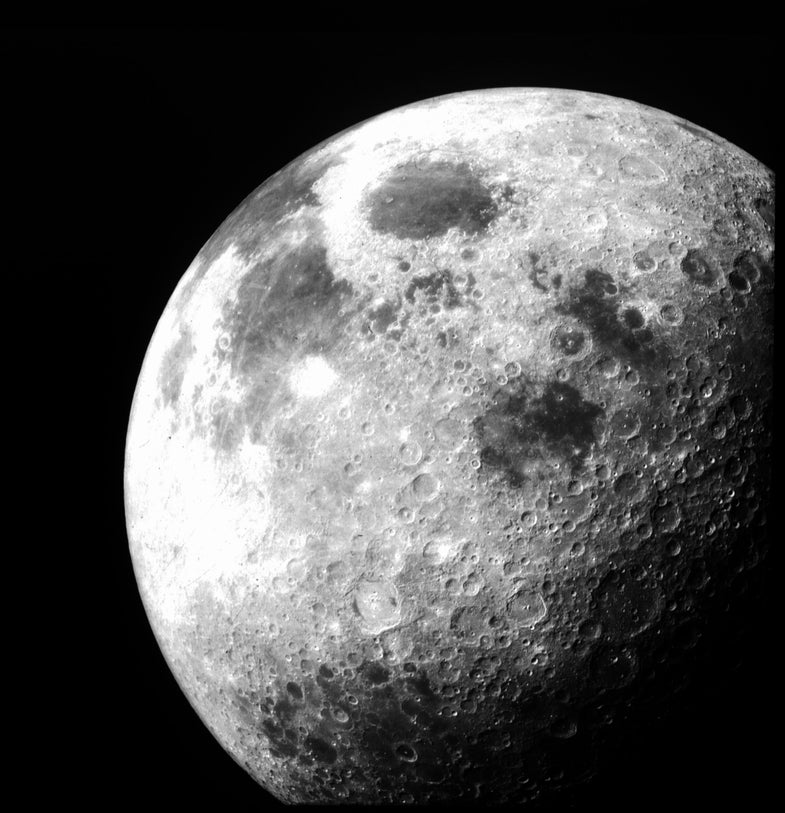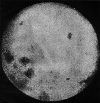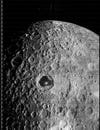On Thursday, October 22, I gave a short talk about the far side of the Moon as part of DNews After Dark, our live show during the Bay Area Science Festival. Lots of people asked about it on various social channels, so here’s the talk I gave as a slideshow. The only thing missing are the bad jokes about my Canadian accent that kept slipping through!
Sources/Links: Luna 3; Luna 3; Soviet lunar missions page; Zond 8; Lunar Orbiter 3; Lunar Orbiter photo gallery; Le Voyage Dans la Lune; Apollo archive on Flikr.
Help us do science! I’ve teamed up with researcher Paige Brown Jarreau to create a survey of Vintage Space readers. By participating, you’ll be helping me improve Vintage Space and contributing to SCIENCE on blog readership. You will also get FREE science art from Paige’s Photography for participating, as well as a chance to win a t-shirt and other perks! It should only take 10-15 minutes to complete. You can find the survey here: http://bit.ly/mysciblogreaders/.
Nearside of the Moon
A small, puzzling space rock may be a shard of the moon that broke away many centuries ago.
Another Nearside View
But we’re not getting into Moon formation stuff. So let’s pretend for a second that it’s October 3, 1957. A handful of people — a few scientists and engineers, and a lot of what you might call “crazies” — want to go to the Moon, but nothing has even left the Earth’s atmosphere and not one of these “crazies” knows anything about the Moon beyond the face that we see. Then on October 4, the Soviet Union launched Sputnik. Long story short, this little 184-pound ball changed the world. It opened up space and everyone was suddenly super keen. Space wasn’t just for crazies anymore. Serious scientists and engineers were getting behind it, not to mention the military that was super keen to not only go there but establish military bases. So unsurprisingly, lunar missions started right away. The US Air Force started launching its Able-slash-Pioneer satellites in August of 1958 and the Soviet Union started launching Luna satellites in September. And there were a lot of failures on both sides — it was early years of space exploration after all! Some satellites failed to reach orbit while others missed their lunar target and ended up orbiting the Sun.
Cleaned up Luna 3
Even cleaned up with the noise removed, you can’t see too much going on here. But the lack of stuff is actually pretty significant. Even these terrible pictures showed a very different face of the Moon. The big dark areas called Mare we see on the near side, the remnants from ancient volcanic eruptions, are missing. Instead, we see a more uniform and more heavily cratered face. And these pictures also showed a face that needed far more pictures to really tell us what was going on. And there were more missions, and programs.
Zond’s First Farside Image
Like Zond. Zond was a Soviet series of unmanned interplanetary probes spun off from a planned Soviet program intended to send cosmonauts to the Moon. Zond 3 was a test flight intended to prove that Soviet technology could communicate across the Earth-Mars distance. It also had cameras on board. It launched on July 18, 1965, and reached the moon in just 33 hours. When it photographed the Moon’s far side, it looked specifically at the areas Luna 3 missed. For the first time, these images showed really distinct features on the far side — mountain ranges, mare (albeit smaller than those on the near side), and craters.
Tsiolkovsky Crater from Lunar Orbiter 3
The first views of the Moon’s farside came from Soviet missions because that nation was really leading in space for the first half of the 1960s. But NASA wasn’t out of the game. By 1965, the United States was surpassing the Soviet Union and was firmly on the way to the Moon with the Apollo program, but first the agency had to understand and photograph the Moon to pick a safe and interesting spot to land its astronauts. This was the goal of the Lunar Orbiter program. The Apollo landing sites were going to be on the near side of the Moon — they had to be if NASA wanted to talk to the astronauts since radio waves can’t travel through the Moon. But because these surveying spacecraft were in orbit, they caught beautifully high resolution images of the Moon’s far side, seeing things up to 6 feet across. The far side of the Moon was increasingly revealed through these incredible images. Two years later, Apollo landed on the Moon and the space race was arguably over. But there were still missions going to and beyond our satellite.
Zond 8’s Plaster Moon
There were more Soviet missions from the Zond program. Zond 8 flew past the Moon on October 24, 1970, on a circumlunar flight with and returned to Earth for a safe splashdown three days later. Among the images it brought back was this fantastic shot of the Moon’s far side. So this isn’t a great picture. It’s pretty mottled and doesn’t show a lot of detail, but I have to say I’ve always loved this image because it’s very similar to…
Le Voyage Dans La Lune
…the plaster Moon from Georges Méliès’ 1902 French silent film “Le Voyage dans la Lune” (A Trip to the Moon). This movie, and the Jules Verne novel that inspired it, inspired those aforementioned “crazies” to want to visit the Moon in the first place. Verne’s “De la Terre à la Lune” was hugely influential.
Apollo 16 Sees the Moon’s Far Side
But of course, by the time Zond 8 returned this “plaster Moon” image, five Apollo missions — 8, 10, 11, 12, and 13 — had already flown around the Moon with humans on board and had taken some incredible images of the far side. And the last four missions, Apollos 14 through 17, also brought back some amazing views of a side of the Moon that only 24 humans have ever seen with their own eyes. So this is all well and good, but why does the far side of the Moon look so different from the near side?
Near and Far Side Comparison
It’s not the case that the Earth protects the near side form impacts, that meteoroids burn up harmlessly in our atmosphere instead of hitting the Moon. It actually comes down to the thickness of the lunar crust. The Moon’s crust isn’t uniformly thick. The near side’s crust is thinner. This means that when the Moon was newly formed and still hot on the inside, volcanoes erupted more frequently, filling in impact craters. And this process continued through the late heavy bombardment, the period when the inner solar system was hammered with small bodies. It’s likely both sides have been hit the same number of times. The difference comes down to lava on the nearside filling in and covering up the craters.
First Look at the Far Side Again
But let’s forget the science and take a minute to think about how familiar our solar system has become. Almost every day we get some stunning new view of Pluto, of Saturn, of any number of moons in the solar system. There’s a lot to learn, still, and a lot to see, but there really isn’t anything left for us to really see for the first time. But we’ve only had this intimate knowledge of our solar system for less than 50 years. For millennia, anything on Earth with eyes has seen one face of the Moon. The far side is familiar now, but we’ve only been able to see it for less than 50 years. That first reveal of something unknown in our solar system, history’s first ever look at something unknown in the solar system, is less than fifty years old. Which is pretty incredible to think about.










